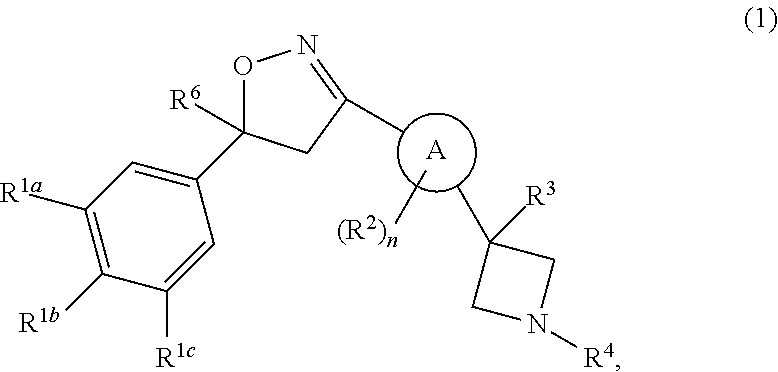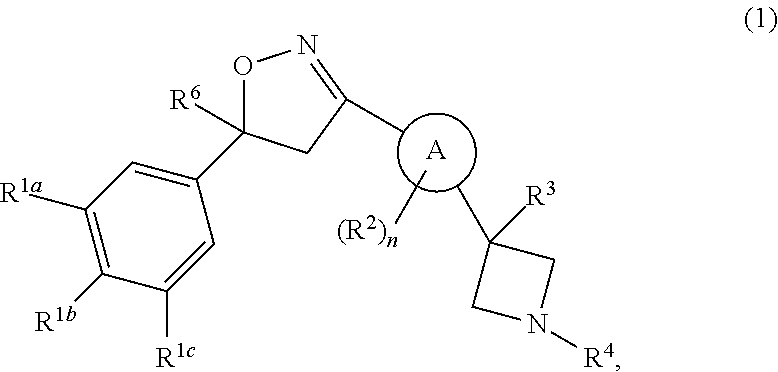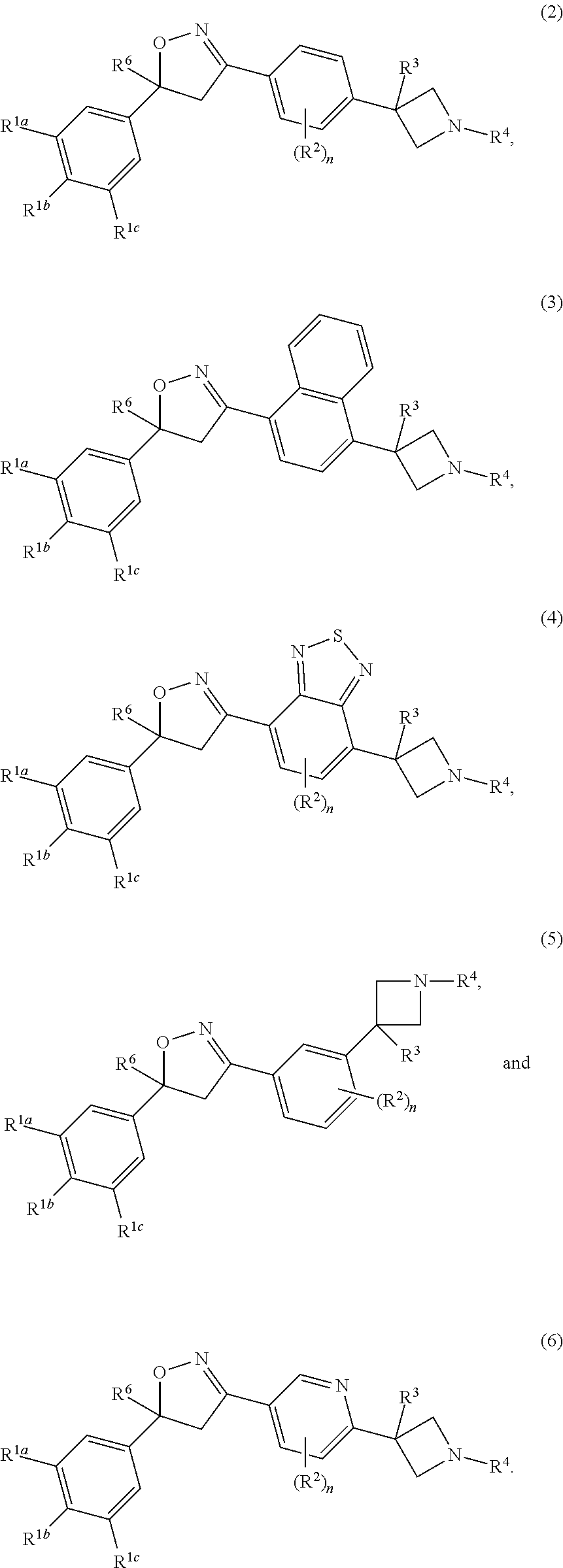Isoxazoline derivatives as antiparasitic agents
a technology of isoxazoline and derivatives, which is applied in the direction of antiparasitic agents, biocides, drug compositions, etc., can solve the problems of accidental ingestion of hazardous chemicals, inability to demonstrate good activity, and good speed of action, and achieve the effect of controlling and preventing endoparasites in animals
- Summary
- Abstract
- Description
- Claims
- Application Information
AI Technical Summary
Benefits of technology
Problems solved by technology
Method used
Image
Examples
example 1
1-(3-fluoro-3-(4-(5-(3,4,5-trichlorophenyl)-5-(trifluoromethyl)-4,5-dihydroisoxazol-3-yl)phenyl)azetidin-1-yl)ethanone
To a solution of 3-(4-(3-fluoroazetidin-3-yl)phenyl)-5-(3,4,5-trichlorophenyl)-5-(trifluoromethyl)-4,5-dihydroisoxazole (Preparation 9, 94 mg) in 2 mL CH2Cl2 was added pyridine (0.05 mL) followed by acetyl chloride (31 mg). The reaction was allowed to stir at room temperature for 1 hour. Water (3 mL) was added. The reaction was diluted with 3 mL of CH2Cl2, stirred for 30 minutes and poured through a phase extractor. The CH2Cl2 layer was collected and concentrated. The crude product from the reaction was adsorbed onto silica and chromatographed on a 12 g silica column eluting with a gradient of 50% EtOAc / hexanes to 100% EtOAc / hexanes to yield 90 mg of the desired compound as a white foam. 1H NMR (CDCl3) δ 7.76 (d, 2H). 7.67 (s, 2H), 7.56 (d, 2H), 4.71-4.31 (m, 4H), 4.12 (d, 1H), 3.72 (d, 1H), 2.01 (s, 3H). LC / MS retention time=3.591 minutes; MS calculated for (C21H15C...
example 2
Cyclopropyl(3-fluoro-3-(4-(5-(3,4,5-trichlorophenyl)-5-(trifluoromethyl)-4,5-dihydroisoxazol-3-yl)phenyl)azetidin-1-yl)methanone
To a solution of the 3-(4-(3-fluoroazetidin-3-yl)phenyl)-5-(3,4,5-trichlorophenyl)-5-(trifluoromethyl)-4,5-dihydroisoxazole (Preparation 9, 94 mg) in 2 mL CH2Cl2 was added pyridine (0.05 mL) followed by cyclopropane carbonyl chloride (31 mg). The reaction was allowed to stir at room temperature for 1 hour. Water (10 mL) was added. The reaction was diluted with an additional 10 mL of CH2Cl2, stirred for 30 minutes at room temperature then passed through a phase separation tube. The CH2Cl2 layer was collected and condensed. The crude material was adsorbed on silica and chromatographed on a 12 g silica column, eluting with a gradient of 20% EtOAc / hexane to 80% EtOAc / hexane. Fractions containing the desired material were combined and concentrated. Et2O (˜½ mL) was added to the resulting film. Placing the flask on high vac overnight resulted in formation of the ...
example 3
3-fluoro-N-methyl-3-(4-(5-(3,4,5-trichlorophenyl)-5-(trifluoromethyl)-4,5-dihydroisoxazol-3-yl)phenyl)azetidine-1-carboxamide
The compound was prepared using a procedure similar to that of Example 2 using methyl isocyanate in place of cyclopropane carbonyl chloride. Yield 124 mg (94%). 1H NMR (CDCl3) δ 7.73 (d, 2H), 7.66 (s, 2H), 7.56 (d, 2H), 4.49-4.40 (m, 2H), 4.28-4.17 (m, 3H), 4.10 (d, 1H), 3.70 (d, 1H), 2.86 (d, 3H). LC / MS retention time=3.559 minutes, MS calculated for (C21H16Cl3F4N3O2), 523.02; found 524.0 M+H.
PUM
| Property | Measurement | Unit |
|---|---|---|
| compositions | aaaaa | aaaaa |
| speed | aaaaa | aaaaa |
| parasitic resistance | aaaaa | aaaaa |
Abstract
Description
Claims
Application Information
 Login to View More
Login to View More - R&D
- Intellectual Property
- Life Sciences
- Materials
- Tech Scout
- Unparalleled Data Quality
- Higher Quality Content
- 60% Fewer Hallucinations
Browse by: Latest US Patents, China's latest patents, Technical Efficacy Thesaurus, Application Domain, Technology Topic, Popular Technical Reports.
© 2025 PatSnap. All rights reserved.Legal|Privacy policy|Modern Slavery Act Transparency Statement|Sitemap|About US| Contact US: help@patsnap.com



